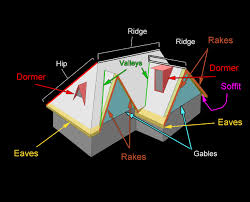Archive for December, 2013
Building a Green Roof
If you have heard about a green or eco roof, or been interested in possibly installing your own, some of the benefits include:
- Decreasing your energy costs
- Cleaning the air
- Reducing urban heat effect
- Beautiful to look at
- Reducing storm water runoff
Your choices may be limited if you want to put a green roof on your existing roof. Although lightweight green roof systems are available, weight is a definite concern. A 20 foot garden can add thousands of pounds of extra weight to your roof. If you have access to the rafters in your attic your local roofer can add reinforcement and lateral supports to shore it up.
Get a Roof Report
Having a structural engineer examine your roof will tell you the load your roof can support and if you will need a roofing company to add support if needed.
Once you have determined the load capacity of your roof, you will want to lay down a water proof liner to protect your home from moisture and also to keep roots from creeping into your roof structure. If your roof has a slope, add a lattice type grid over the liner to keep the dirt and plants from sliding off.
You will need to mix your potting soil with sand or dirt, peat moss or coconut husks and organic matter and usually a water absorbing material to keep the plants from drying out. Your local nursery will probably be the best source of information on the type of soil you will need and the plants that will grow well in your climate.
When considering the vegetation you want to put on your roof things to consider are:
- Amount of work you are willing to put in to maintaining the greenery
- Ornate plants will need more work than moss or sedums
- Wildflowers will attract butterflies, birds and bees
- Grasses will need to be mowed
There are several companies now that specialize in green roof systems, before you invest in your first plant you should make sure your roof can support the added weight.
WalMart Green Roof Project

In Portland Oregon, the Hayden Meadows WalMart’s 92,000 square foot roof is a green roof experiment. 40,000 square feet of the roof is divided into 3 sections each with different soil depths, the rest of the roof is the standard roofing materials for a flat roof for a control section.
Portland State University’s Green Building Research Laboratory will be comparing rainwater absorption and cooling benefits. WalMart gave the university a $133,000 grant to spend the next two years collecting data from the rooftop weather station and sensors in 3 different sections of the roof.
Able to do side by side tests
The students will test the temperatures of the soil to determine if the green roofs lower the urban air temperatures, help reduce the cost to cool the interior of the building and reduce rainwater runoff into the city drains.
Other area agencies are taking advantage of the unique situation of the 3 different soil levels and control section for further green roof studies.
- Portland’s Bureau of Environmental Services also are taking part of the Walmart green roof study by comparing the amount of storm water runoff in the 3 different sections allowing a side by side comparison.
- An environmental consulting company, Cadmus group will be testing the green roof’s cooling properties to determine the efficiency of the buildings air conditioning units.
- Portland Audubon Society will be counting the number of birds that visit the vegetative green roof.
Walmart designed the roof with research in mind to determine if they can cut the cost of doing business. The WalMart spokesperson said they are hoping to determine the best climate for the green roofs to save the most money.
$100,000 plus for New Slate Roof

In Stroudsburg Pennsylvania, the Stroud Mansion needs a new roof that could cost over $100,000 to replace the slate roof from 1920. The historic building was built in 1795 in Stroudsburg Pennsylvania to be a home for founder Jacob Stroud’s oldest son John.
The 3 ½ story building is now home to Monroe County Historical Society Museum and Elizabeth D. Walters Library. The building was saved from demolition in 1920 and was added to the National Register of Historic Places in 1979.
The Georgian style mansion has 12 rooms which house memorabilia of the county’s history. Volunteers preserve and catalog memorabilia that includes artifacts from Native Americans to present day. The popular third story military room has been closed to visitors due to water damage.
New Patch Jobs a Waste of Money
The roof has received several patch jobs from local roofers through the years. They have tried to put off replacing the costly new roof, but have reached the point where the repairs are a waste of money.
Roofing contractors are now saying a full replacement is the only option. The roof of the addition built in 1893 in the rear of the building will also be replaced. The slate will be replaced as well as the copper flashing and masonry work on the two chimneys.
Thousands of dollars have already been donated by members and supporters, now they are hoping for grants to cover the rest of the project cost. They have requested $85,000 from the state’s Local Share Account which uses a portion of the gambling revenues from Mount Airy Casino Resort.
Slate Roofs

Slate is a fine grain metamorphic rock that can be made into roofing tiles that come in a wide variety of sizes, thicknesses and colors. Slate is one most fire resistant roofing material available. Slate accounts for much less waste than asphalt shingles that need to be replaced at 20 years or less.
Slate tiles have 2 lines of breakability, cleavage and grain making it possible to split the stone into thin sheets. Slate tiles are relatively flat and easy to stack while retaining a natural look. Slate roofs can last 150 years or more.
In some parts of the country slate roofs were common and were standard roofing materials. Today slate roofs are expensive and not as easy to come by as simply going to the quarry and picking some up. Technology and cost have made way for cheaper and lighter asphalt shingles.
Earliest recorded Slate Roof
In 1287 in North Wales England is the first recorded slate roof. Slate was very expensive so only the wealthy were using slate for their castles and churches.
In the 1800’s Spain improved the quarrying process and made slate available for the masses. In 1785 the first U.S. quarry opened in Pennsylvania.
After the civil war slate production increased to over 200 quarries on the east coast, starting in Pennsylvania and spreading east. Vermont is still the state with the most slate production with the highest quality stone.
Slate can cost up to 5 times more than asphalt roofing and if your local roofer doesn’t know what they are doing, it can be like having no roof protection at all.
Parts of a Roof

A roof is the uppermost covering of a structure. Its purpose is to keep the elements out and the inside of the building or home dry and comfortable. Depending on the climate or culture, it can be covered with anything from banana leaves to high tech solar roof tiles.
The roof angle also varies by climates; in areas that receive a lot of rain or snow the roofs have a steeper pitch or angle to allow runoff. Local roofers will have the experience and skill to work on the steeper angles.
Other parts of a roof include:
• Truss- is a framework of beams that support the roof.
• Rafters-are the beams that run from the top of the roof to the bottom.
• Eave- is the bottom edge of a roof that hangs over the rest of the home.
• Fascia- trim used to cover the rafter end of the eaves
• Soffit- is a finished under side of the eaves.
• Hip- the high point formed where two sloping sections of a roof meet. Found on roofs with more than two main faces.
• Rake- the side edge of a roof, which runs from eave to ridge or hips.
• Ridge- is the highest point of the roof also running the length of the roof.
• Valley- a trough formed by two downward sections of roof meeting at an angle.
• Decking or sheathing- are the panels that cover the rafters.
• Roof felt or underlayment- goes over the plywood decking to seal the roof from the elements.
• Shingles or tile- are the outermost part of the roof; it can be asphalt shingles, roll roofing, wood shingles, wood shakes, tar and gravel, metal panels, clay or concrete tiles. These roof materials function is to make a barrier against the elements.
• Flashing- metal pieces used to keep water from leaking in where two parts of the roof meet.
• Drip edge- edging that is at the roof end to allow water to run off.







